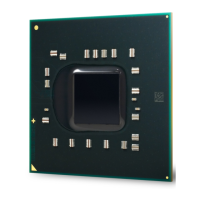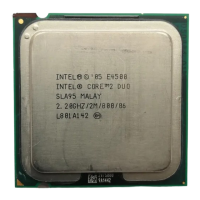LGA775 Socket Heatsink Loading
26 Thermal and Mechanical Design Guidelines
3.2 Processor Thermal Solution Performance
Assessment
Thermal performance of a heatsink should be assessed using a thermal test vehicle
(TTV) provided by Intel. The TTV is a stable heat source that the user can make
accurate power measurement, whereas processors can introduce additional factors
that can impact test results. In particular, the power level from actual processors
varies significantly, even when running the maximum power application provided by
Intel, due to variances in the manufacturing process. The TTV provides consistent
power and power density for thermal solution characterization and results can be
easily translated to real processor performance. Accurate measurement of the power
dissipated by an actual processor is beyond the scope of this document.
Once the thermal solution is designed and validated with the TTV, it is strongly
recommended to verify functionality of the thermal solution on real processors and on
fully integrated systems. The Intel maximum power application enables steady power
dissipation on a processor to assist in this testing.
3.3 Local Ambient Temperature Measurement
Guidelines
The local ambient temperature T
A
is the temperature of the ambient air surrounding
the processor. For a passive heatsink, T
A
is defined as the heatsink approach air
temperature; for an actively cooled heatsink, it is the temperature of inlet air to the
active cooling fan; for a liquid cooled solution it is the temperature of the air entering
the heat exchanger.
It is worthwhile to determine the local ambient temperature in the chassis around the
processor to understand the effect it may have on the case temperature.
T
A
is best measured by averaging temperature measurements at multiple locations in
the heatsink or heat exchanger inlet airflow. This method helps reduce error and
eliminate minor spatial variations in temperature. The following guidelines are meant
to enable accurate determination of the localized air temperature around the
processor during system thermal testing.
For active heatsinks and liquid cooled solutions, it is important to avoid taking
measurement in the dead flow zone that usually develops above the fan hub and hub
spokes. Measurements should be taken at four different locations uniformly placed at
the center of the annulus formed by the fan hub and the fan housing to evaluate the
uniformity of the air temperature at the fan inlet. The thermocouples should be
placed approximately 3 mm to 8 mm [0.1 to 0.3 in] above the fan hub vertically and
halfway between the fan hub and the fan housing horizontally as shown in
Figure 5
and
Figure 6 (avoiding the hub spokes). Using an open bench to characterize an
active heatsink can be useful, and usually ensures more uniform temperatures at the
fan inlet. However, additional tests that include a solid barrier above the test
motherboard surface can help evaluate the potential impact of the chassis. This
barrier is typically clear Plexiglas*, extending at least 100 mm [4 in] in all directions
beyond the edge of the thermal solution. Typical distance from the motherboard to
the barrier is 81 mm [3.2 in]. For even more realistic airflow, the motherboard should
be populated with significant elements like memory cards, graphic card, and chipset

